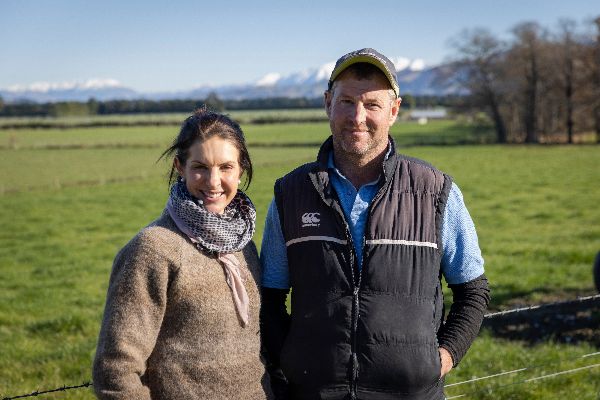Baseline Set For Subsurface Irrigation Trial
While Cust dairy grazers Gary and Penny Robinson are disappointed not to have collected the data they were hoping for from their subsurface drip irrigation trial due to a wet summer, the couple have established a baseline for the next irrigation season which they hope will follow a more normal weather pattern to enable data collection.

Gary and Penny are participating in a farming innovation project, which examines how the next generation of farmers are using innovation to improve their farming practices. Waimakariri Landcare Trust (WLT) and Waimakariri Irrigation Limited (WIL) have partnered with the Ministry for Primary Industries (MPI) for the project, with support from MPI’s Sustainable Food and Fibre Futures fund along with Environment Canterbury, Ballance, and DairyNZ.
The subsurface drip irrigation system on their two-hectare test block in Cust consists of a network of valves, driplines, pipes, and emitters that are installed in tape below the surface of the soil. The evenly spaced emitters slowly release water directly to the root zone of plants which differs from traditional irrigation systems that apply water to the surface of the soil.
At the beginning of autumn Gary and Penny invited Carrfields and Ballance to visit the trial block to take pasture samples which have been used to provide a baseline for the next irrigation season. Penny says it is great to have two key industry partners on board to provide technical assistance with the trial.
“We mowed five consistent strips of the same width and length of pasture for analysis in terms of yield and tonnage per hectare of dry matter. This has given us a useful baseline which we can use for the following season.
“Having Carrfields and Ballance involved in the project is important as they are both invested in farming innovations. Carrfields can see that subsurface irrigation is the future of farming and Ballance are keen to see how we can use subsurface technology to apply precise amounts of fertiliser to the root zone of plants.”
Now that Gary and Penny have their baseline figures established, they plan to do an on-farm comparison between their subsurface irrigated trial block and the unirrigated section of the block. They will also compare the subsurface drip irrigation system with the traditional sprinkler irrigation system operating in another part of their farm.
“We have learned how the system functions at a practical level and moving forwards we are hoping for a typical irrigation season weatherwise so we can get the data to share with potential customers and partners. Having a baseline already in place allows us to track our progress throughout the season and make those important comparisons to prove the benefits of subsurface irrigation.”
Penny says one of the unique benefits of subsurface drip irrigation is the precision control of the system which allows farmers to use their water resource more efficiently resulting in cost savings and environmental benefits.
“The exact amount of water is applied directly to the roots which means you are not using any more water than you absolutely need to because you rely on data from your moisture probes which makes everything that much more accurate.
“You are irrigating to scientific data, not to what your eye can see. The result is overall more stable growth with better quality plants and a much better use of your water resource.”
For the next irrigation season Gary says the focus will be on measuring how much water is used by the subsurface irrigation system, the pasture growth rate and measuring how many tonnes per hectare of dry matter can be removed from the trial paddock.
“While it hasn’t been an ideal season for a trial, we are hopeful that we will be able to gather the data we need next season, and we will be ready to flip the switch on the subsurface irrigation system as soon as the moisture probes indicate we need to start irrigating.”


 Great Journeys New Zealand: Scenic Plus Winter Menu Launched
Great Journeys New Zealand: Scenic Plus Winter Menu Launched Tourism New Zealand: Tourism New Zealand Invites The World To Find Their 100% Pure New Zealand In New Global Campaign
Tourism New Zealand: Tourism New Zealand Invites The World To Find Their 100% Pure New Zealand In New Global Campaign Bill Bennett: Comcom warns 2degrees over satellite marketing
Bill Bennett: Comcom warns 2degrees over satellite marketing Transpower: Major Electricity Development For Western Bay Of Plenty A Step Closer
Transpower: Major Electricity Development For Western Bay Of Plenty A Step Closer Alcohol Beverages Council: Turning The Tide - New Zealanders Unite To Curb Harmful Drinking
Alcohol Beverages Council: Turning The Tide - New Zealanders Unite To Curb Harmful Drinking University of Auckland Business School: Economists Urge Action To Prevent ‘AI Poverty Traps’
University of Auckland Business School: Economists Urge Action To Prevent ‘AI Poverty Traps’


